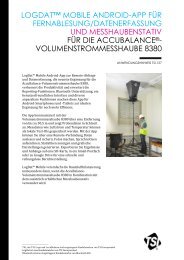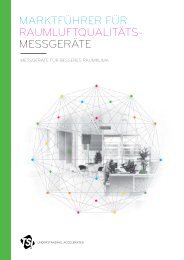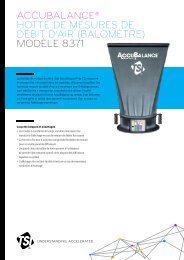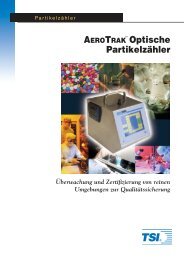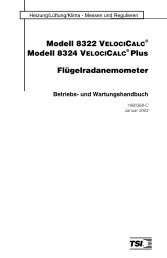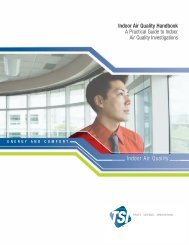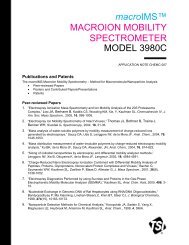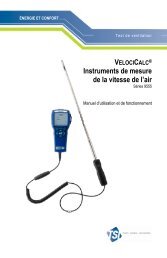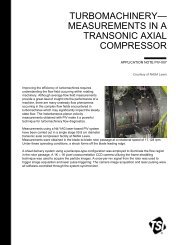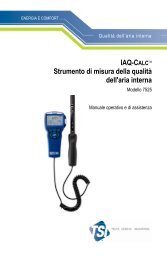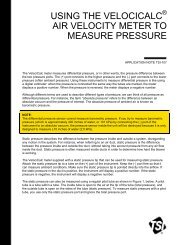Model 3340 Laser Aerosol Spectrometer Bibliography - Tsi
Model 3340 Laser Aerosol Spectrometer Bibliography - Tsi
Model 3340 Laser Aerosol Spectrometer Bibliography - Tsi
You also want an ePaper? Increase the reach of your titles
YUMPU automatically turns print PDFs into web optimized ePapers that Google loves.
from alpha and beta sources. Charge distribution measurements were performed on alumina dust (Al),<br />
Arizona road dust (ARD), potassium chloride (KCl), sodium chloride (NaCl) and di-octyl sebacate<br />
(DOS) liquid particles. <strong>Aerosol</strong> generation devices include a Collison atomizer, a condensation<br />
aerosol generator and a fluidized bed dust generator. Our work provides experimental charge<br />
distribution data for comparison with simple models of electrification theory. Experimental results<br />
showed that charge levels of atomized KCl and NaCl particles were high and decreased as the<br />
dissolved ion concentration increased. DOS particles generated by evaporation-condensation were<br />
both neutral and moderately charged. These conclusions support the existence of a dipole layer at the<br />
liquid-gas interface that interacts with dissolved particles and changes their charge state. Alumina and<br />
ARD generated by the fluidized bed disperser are highly charged due to strong contact electrification<br />
during dispersion. In most cases, the charge on generated aerosols could be reduced to Boltzmann<br />
charge equilibrium conditions by commonly used radioactive neutralizers.<br />
Lin, J.-C.; Gentry, J.W. “Development of particle morphology of drying drops containing dissolved and<br />
suspended solids,” Journal of <strong>Aerosol</strong> Science, 29, (1998) S903–S904.<br />
Marui, Y.; Chang, Y.C.; Lin, J.C.; Curto, E.; Nadarajan, A.; Ranade, M.B.; Gentry, J.W.<br />
“Characterization of a New Inertial Classifier,” Journal of <strong>Aerosol</strong> Science, 29, (1998) S337–S338.<br />
Mavliev, R.; Wang, H.-C. “On the Particle Growth in a Turbulent Mixing CNC,” Journal of <strong>Aerosol</strong><br />
Science, 29, (1998) S65–66.<br />
Nyeki, S.F.; Li, E.; Weingartner, N.; Streit, I.; Colbeck, H. W.; Gäggeler, and Baltensperger, U. “The<br />
Background <strong>Aerosol</strong> Size Distribution in the Free Troposphere: An Analysis of the Annual Cycle at a<br />
High-Alpine Site,” J. Geophys. Res., 103:D24, (1998) 31,749–31,761.<br />
Abstract: Measurements during free tropospheric (FT) and planetary boundary layer (PBL)<br />
conditions were conducted over an annual cycle at the Jungfraujoch high-Alpine research station<br />
(3454 m), Switzerland, in order to establish diurnal and seasonal cycles of the background continental<br />
aerosol over central Europe. Using a condensation nucleus counter (TSI 3025) and an optical particle<br />
counter (PMS Las-X) from June 1996 to May 1997, the following were determined: (1) accumulation<br />
mode lognormal parameters and (2) number concentrations for the nucleation (diameter d < 0.1 μm),<br />
accumulation (0.1 ≤ d ≤ 1.0 μm), and part of the coarse (1.0 < d ≤ 7.5 μm, designated coarse) modes.<br />
Lognormal parameters were found to be similar for FT and PBL conditions, and exhibited a weak<br />
seasonality in geometric median diameter dGN = 0.13 and 0.10 μm, and standard deviation σG = 1.73<br />
and 1.64 for summer and winter, respectively. <strong>Aerosol</strong> number concentrations in each mode exhibited<br />
a more pronounced seasonality, with FT concentrations being lower than those for PBL. Summer and<br />
winter FT median concentrations for the nucleation, accumulation, and coarse modes were 405 and<br />
195 cm -3 , 114 and 26 cm -3 , and 0.052 and 0.014 cm -3 , respectively. These results provide tentative<br />
support of other long-term observations that the FT background aerosol mode appears to vary mainly<br />
in concentration rather than accumulation mode shape. Further analysis indicated that only the total<br />
concentration in each mode varied with weather type and a classification between that of a remote<br />
continental and polar aerosol model was found for the Jungfraujoch.<br />
Poulida 1 , O.; Schwikowski 2 , M.; Baltensperger 2 , U.; Staehelin 1 , J.; Gaeggeler 2 , H.W. “Scavenging of<br />
Atmospheric Constituents in Mixed Phase Clouds at the High-Alpine Site Jungfraujoch—Part II.<br />
Influence of Riming on the Scavenging of Particulate and Gaseous Chemical Species, Atmospheric<br />
Environment, 32:23, (Dec. 1998) 3985–4000.<br />
1 2<br />
Atmospheric Physics, ETH Hoenggerberg, CH-8093 Zurich, Switzerland. Paul Scherrer Institute,<br />
CH-5232 Villigen PSI, Switzerland.<br />
Abstract: The importance of riming as transfer mechanism of pollutants from the atmosphere into the<br />
snow in mixed phase clouds was investigated at the Jungfraujoch (3450 m a.s.l), during two intensive<br />
-20-



